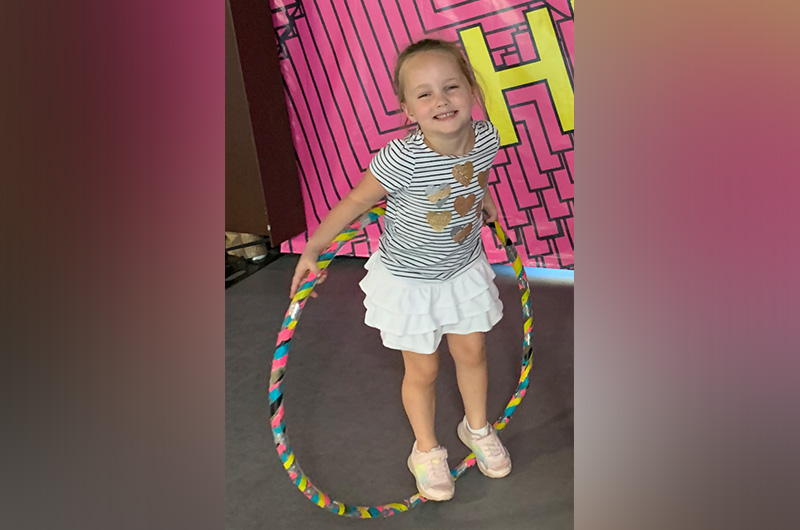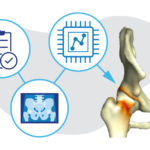After hip dysplasia, Emma smashes her cast

When she could walk again, Emma Wilkinson and her parents threw a big party. Diagnosed with hip dysplasia at the age of 4, Emma had spent 10 weeks in a spica cast that made almost all physical activity impossible. Now, baseball bat in hand, she took aim at a piñata replica of her cast while friends and family cheered.
Developmental hip dysplasia occurs when a child’s hip socket does not form completely. In its most severe form, the head of the thighbone dislocates out of the hip socket (acetabulum). Severe hip dysplasia is often diagnosed in a child’s first year, but Emma’s symptoms were subtle. Her parents, Mike and Michele, noticed her left leg dragged sometimes when she walked. At times, she would ask her father to carry her because her leg hurt. But she outpaced most kids her age. Watching her sprint up and down the soccer field, it was easy to believe everything was fine.
A surgeon experienced in hip dysplasia
Mike and Michele contacted Dr. Eduardo Novais of the Child and Young Adult Hip Preservation Program after an x-ray showed Emma’s left thighbone completely outside of the socket. They had already met with a pediatric surgeon in Greenville, South Carolina. “He was a nice guy and we had confidence in his abilities,” says Mike, adding that Greenville is only a three-hour drive from their home in Charleston. “But we wanted the best for Emma.” They liked the fact that Dr. Novais focused specifically on repairing hips. “This is what he does. When we talked with him, he had already performed a couple of hip dysplasia surgeries that week.”

The Wilkinson family flew from Charleston to Boston on Thanksgiving 2018. Emma had surgery the following Wednesday. Dr. Novais repositioned the top of the thighbone in the acetabulum and made cuts in her pelvic bone to reshape the socket so it would fit more securely around the top of her thighbone. He also removed a section of her femur to realign the thighbone to the proper, functional position in the socket. Finally, he attached screws and a plate on her femur and inserted two pins in her pelvic bone to ensure everything would heal correctly.
10 weeks in a spica cast
The hardest part came next. Emma — soccer player, playground thrill-seeker, child in perpetual motion — faced 10 weeks in a cast that immobilized her legs. The spica cast extended from her chest to her ankles, holding her hips stable as her bones repaired themselves. Her parents knew the cast was an essential part of her recovery. But for Emma, 10 weeks of enforced stillness seemed like a lifetime.
“Her emotions went through several stages,” remembers Mike. The first stage was sadness, as Emma came to understand how restricted she would be in the cast. About three weeks after the surgery, she asked her father, “Am I ever going to get this cast off?” Mike and Michele would do their best to cheer their daughter up, then slip off to deal with their own feelings. “That was probably one of the most emotional times of my life,” says Mike. “It was hard on the whole family.”

Fortunately, family and friends got involved almost right away. One friend built a special table that Emma could sit at in her cast that had room for others as well. She became a champion Uno player and spent hours playing or coloring with friends who came to visit. A neighbor brought over a box of wrapped gifts — one for each day Emma had left in the cast. “Each package contained a troll, Shopkin, or Hatchimal,” says Mike. “It was perfect. It gave her something to look forward to every single day.”
Emma rising
In early February, Emma and Mike flew back to Boston to have the spica cast removed once and for all. On the plane back to Charleston that night, Emma told her dad she wanted to show her mom and little sister, Mikah, that she could walk. “Dr. Novais told us it would probably be a few days before she felt comfortable walking,” says Mike. “But as soon as we got home, she pushed me away and walked.”
She was wobbly at first. Her muscles took time to regain their strength. But with no cast to hold her back, Emma’s determination took over. By the time of her smash-the-cast party in March, she was walking with ease. In July, seven months after the surgery, Dr. Novais removed the plate, screws, and pins from Emma’s leg and hip. By the time she started kindergarten in the fall, she could walk with almost no limp at all.

These days, Emma is all about action: on the playground, in hip-hop class, and on the tennis court. One day recently, Mike overheard her telling a classmate that she’d had hip surgery but was all better now. For the most part, she appears to remember only the good parts of her ten weeks in a cast. “She remembers people coming over to hang out with her, but as far as the emotional part, she’s past it,” says her dad.
Air travel tips when your child has had surgery
Contact airport security 72 hours (or more) in advance. As the Wilkinsons prepared to fly home with Emma in a cast, Nurse Kristen Friel contacted the Massachusetts Port Authority on their behalf. When they arrived at the terminal, a passenger support specialist met them with a wheelchair and helped them through security. “They got us to the gate with none of the usual fuss or waiting in line,” says Mike.
According to the Transportation Security Administration’s website, passenger support services are available for people traveling with medical conditions or disabilities at airports throughout the country. Be sure to contact the agency at least 72 hours before your flight.
Notify the airline. Several days before each flight, Mike called the airline to let them know they would be traveling with a child in a spica cast. As a result, the family was allowed to board the plane early and had seats with extra leg room. “The transportation piece is an important detail,” says Mike. “Thankfully, the passenger support services and the airline helped make it pretty low stress.”

Learn more about the Child and Young Adult Hip Preservation Program.
Related Posts :
-

Jenna’s comeback from PAO surgery
By the time Jenna was 14, her off-and-on hip pain had become an always-on issue. The accomplished soccer player and runner ...
-

Hip pain resolved, Louise takes steps to become a surgeon
Louise Atadja couldn’t remember the last time her two big toes touched. Ever since she was born, her feet ...
-

AI could change the way we look at hip preservation
Orthopedic surgeons and biomedical engineers are trained to approach adolescent and young adult hip pain from two different perspectives. Surgeons ...
-

Relationship talks: Staying together through a child's illness
Among the many stresses of having an ill or injured child, parents often feel a strain on their marriage. Whenever ...





